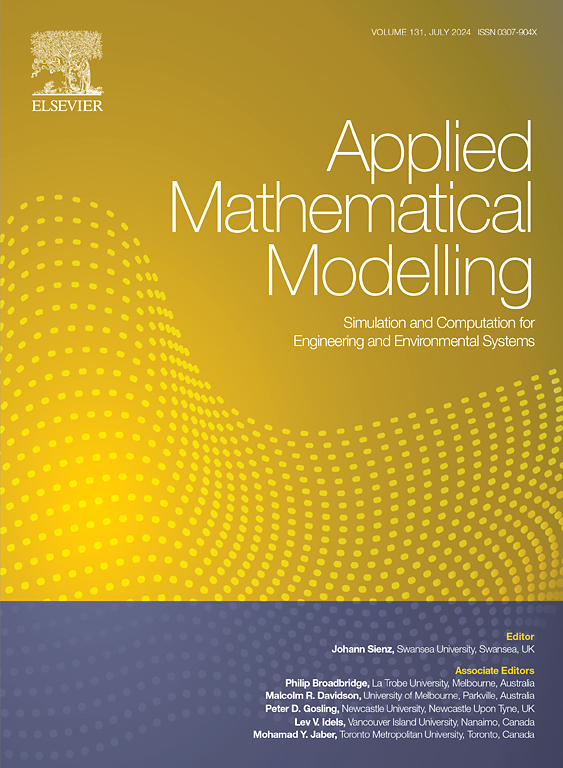Last-train timetable synchronization for service compatibility maximization in urban rail transit networks with arrival uncertainties
IF 4.4
2区 工程技术
Q1 ENGINEERING, MULTIDISCIPLINARY
引用次数: 0
Abstract
The last train services of urban rail transit offer all passengers the final chance to reach their destinations. In the context of multimodal transport, considering the random delayed arrivals of late-night vehicles of other transport modes at urban hub stations and their adverse effects on multimodal passengers transferring to urban rail transit, a probabilistic scenario set is established to determine the arrival uncertainties of multimodal passengers. In each scenario, the timetable synchronization problem is formulated as a mixed-integer nonlinear programming model that requires a performance trade-off between destination reachability and the remaining path distance of both non-multimodal and multimodal passengers, integrally termed last train service compatibility. Through linearization techniques, the model is transformed into an equivalent mixed-integer linear programming form, which can be efficiently solved using the Gurobi solver to obtain the optimal last train timetable for each scenario and form an alternative scheme set. An improved probabilistic scenario set-based regret value theory is then developed, in which a novel regret value calculation method is proposed. The scheme with the minimum total weighted opportunity loss in all scenarios is selected as the optimal robust. Real case experiments based on the Chengdu–Chongqing high-speed railway line and Chengdu metro network are conducted to test the performance of our model. The results show that compared with the original timetable, the optimized timetable reduces the number of unreachable passengers by 34.29 % and the sum of the average remaining path distance of non-multimodal and multimodal passengers by 57.43 % with the help of path planning for all passengers. The proposed approach is proven not only to balance the demands of both reachable and unreachable passengers, but also to significantly improve the robustness of the last train timetable to arrival uncertainties of multimodal passengers and reduce their service inequity.
在具有到站不确定性的城市轨道交通网络中同步末班车时刻表,实现服务兼容性最大化
城市轨道交通的末班车服务为所有乘客提供了到达目的地的最后机会。在多式联运的背景下,考虑到深夜其他交通方式车辆在城市枢纽站的随机延迟到达及其对换乘城市轨道交通的多式联运乘客的不利影响,建立了一个概率情景集来确定多式联运乘客到达的不确定性。在每种情况下,时刻表同步问题都被表述为一个混合整数非线性编程模型,要求在目的地可达性与非多式联运乘客和多式联运乘客的剩余路径距离(统称为末班车服务兼容性)之间进行性能权衡。通过线性化技术,该模型被转化为等效的混合整数线性规划形式,并可使用 Gurobi 求解器进行高效求解,从而获得每种情景下的最优末班车时刻表,并形成备选方案集。然后,建立了基于概率方案集的改进遗憾值理论,并在此基础上提出了一种新颖的遗憾值计算方法。在所有方案中,总加权机会损失最小的方案被选为最优稳健方案。基于成渝高速铁路线和成都地铁网络的实际案例实验检验了模型的性能。结果表明,与原始时刻表相比,优化后的时刻表在对所有乘客进行路径规划的帮助下,使无法到达的乘客数量减少了 34.29%,非多式联运乘客和多式联运乘客的平均剩余路径距离之和减少了 57.43%。事实证明,所提出的方法不仅能平衡可到达乘客和不可到达乘客的需求,还能显著提高末班车时刻表对多式联运乘客到达不确定性的稳健性,减少其服务不公平现象。
本文章由计算机程序翻译,如有差异,请以英文原文为准。
求助全文
约1分钟内获得全文
求助全文
来源期刊

Applied Mathematical Modelling
数学-工程:综合
CiteScore
9.80
自引率
8.00%
发文量
508
审稿时长
43 days
期刊介绍:
Applied Mathematical Modelling focuses on research related to the mathematical modelling of engineering and environmental processes, manufacturing, and industrial systems. A significant emerging area of research activity involves multiphysics processes, and contributions in this area are particularly encouraged.
This influential publication covers a wide spectrum of subjects including heat transfer, fluid mechanics, CFD, and transport phenomena; solid mechanics and mechanics of metals; electromagnets and MHD; reliability modelling and system optimization; finite volume, finite element, and boundary element procedures; modelling of inventory, industrial, manufacturing and logistics systems for viable decision making; civil engineering systems and structures; mineral and energy resources; relevant software engineering issues associated with CAD and CAE; and materials and metallurgical engineering.
Applied Mathematical Modelling is primarily interested in papers developing increased insights into real-world problems through novel mathematical modelling, novel applications or a combination of these. Papers employing existing numerical techniques must demonstrate sufficient novelty in the solution of practical problems. Papers on fuzzy logic in decision-making or purely financial mathematics are normally not considered. Research on fractional differential equations, bifurcation, and numerical methods needs to include practical examples. Population dynamics must solve realistic scenarios. Papers in the area of logistics and business modelling should demonstrate meaningful managerial insight. Submissions with no real-world application will not be considered.
 求助内容:
求助内容: 应助结果提醒方式:
应助结果提醒方式:


